1980 The north of England at least had a good covering of snow as the New Year opened, with some parts enjoying both sun & snow.
Freezing rain led to icing conditions on the Southern Region during the morning of January 3rd, particularly between Woking & Basingstoke. Numerous mainline services were affected, with many requiring assistance from diesel locomotives. Also heavily impacted were the lines in the Earley and Camberley areas.
Flooding again closed the down line at Dawlish on January 21st for four hours and near Parsons tunnel on February 9th & 10th.
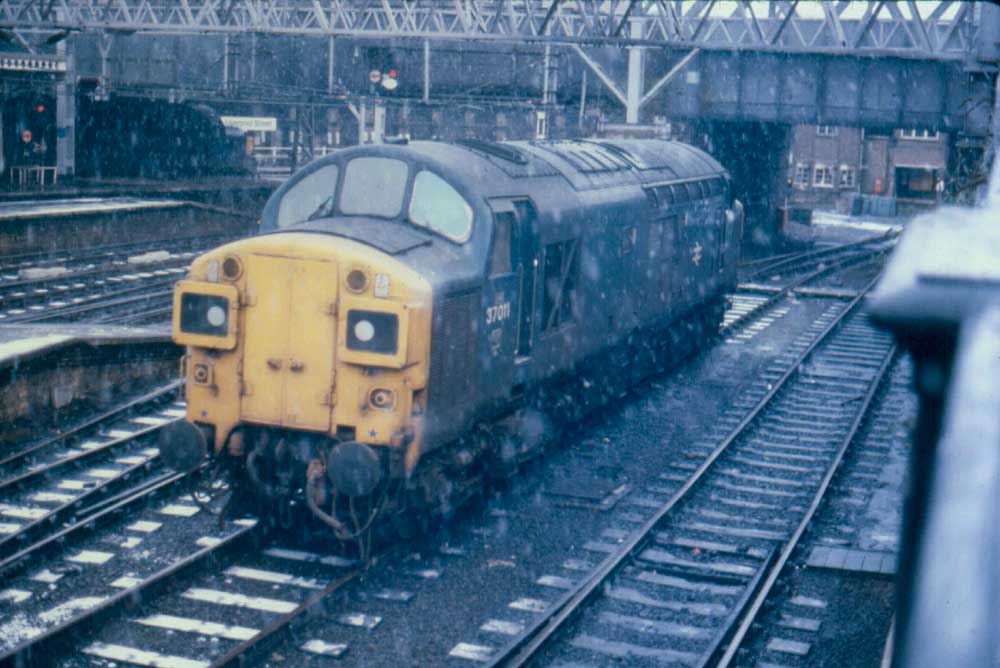
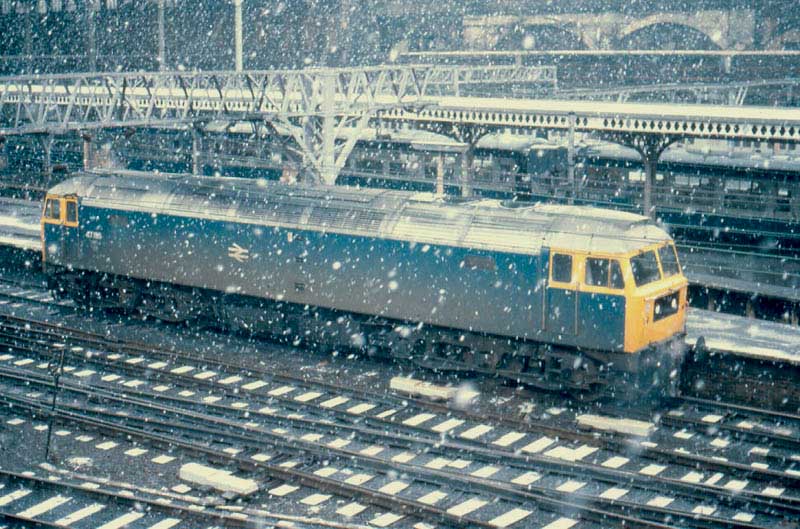
The afternoon of June 25th brought unusual weather to eastern Kent with torrential rain, hail and some snow in an area bounded by Sevenoaks on the west and Herne Bay & Canterbury in the east. Sevenoaks was particulary badly hit with flooding affecting some evening rush hour services.
Severe gales in the Irish Sea on July 20th caused diversion of the Isle of Man Steam Packet Company's Llandudno - Douglas excursion steamer to Liverpool. A twelve coach special hauled by 47013 returned the passengers to Llandudno!
On July 23rd localised severe electrical storms affected the WCML between Bletchley & Rugby. A lightning strike hit signalling equipment shortly before 10am causing extensive delays until the signalling systems were restored during the late afternoon. Three days later on July 26th heavy storms in the West Midlands caused flooding which damaged signalling equipment affecting the WCML and some NE/SW services. Some Birmingham - Euston services were cancelled, with others turning round at Coventry. The delays affected services for most of the day. On July 27th heavy rain washed out the track near Barrhill, stranding the previous day's 21.00 Euston - Stranraer. Passengers walked to the nearest road and were taken by buses to Stranraer. The stranded train was not removed until July 30th. Also on July 27th flooding in the Culloden area impacted services on the Highland mainline. A storm on July 29th caused a landslip near Old Hill, Stourbridge services were cancelled for the day.
Icing on December 8th in eastern Kent caused problems to several early morning passenger services, 33042 & 73109 assisted at least two services which had suffered from severe arcing.
![]()
1981 The New Year got off to a stormy start with heavy rain and snow affecting the west of Scotland, with much flooding in Ayrshire and landslips on the West Highland closing the line between Taynuilt and Dalmally from January 2nd to 4th. On January 2nd a retaining wall collapsed at Mauchline leading to the diversion of mainline services via the WCML and local services terminating at Kilmarnock and Dumfries. On January 6th a landslip south of Barhill caused the cancellation of several services between Girvan & Stranraer.
The third week of January found the Pennines well covered with snow.
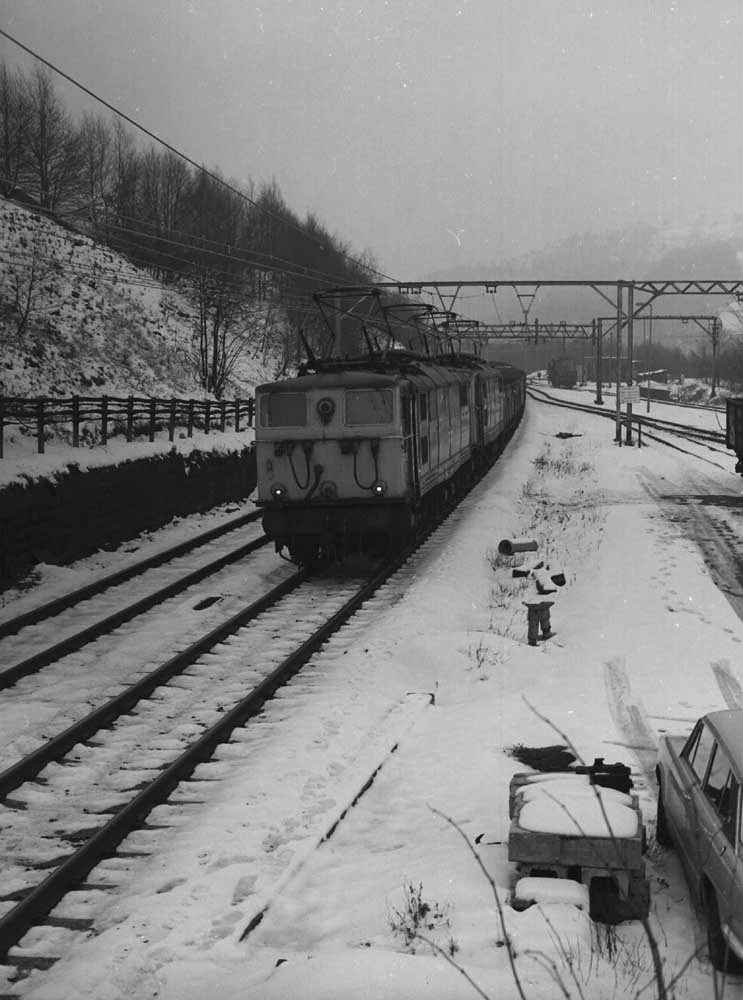
The Midlands also received a covering of snow in the third (?) week of February.
Gale force winds on March 21st led to a tree being blown across the tracks at Teignmouth causing considerable delays. Elsewhere heavy rain in the Swindon area led to problems with an embankment becoming unstable west of the city.
On April 22nd/23rd heavy snow fell on the Midlands northwards. Heavy snows (including a blizzard) created operating difficulties in the south and west on April 24th-26th, most of the affected areas had at least eight inches of snow, parts of Gloucestershire had at least two feet! Services operating into Paddington were particularly affected.
Blizzards on the night of April 25th/26th north of London caused interruptions to the National Grid power supply which affected operations on the WCML. By midnight blizzard conditions were reported as far south as Bedford and Aylesbury and as far north as Rugby. The 22.35 Euston - Rugby with AM10 No.056 became stopped at Wolverton, trapping several services, remaining stuck for at least two hours until an empty service sent down from Northampton got things moving. The fluctuating power supply halted electric powered trains at several locations, then ice and snow problems affected the pantographs when power was restored. Compounding the issues was an engineering occupation that had seen the removal of several track panels between Hanslope & Rugby prior to the onset of the blizzard.
After midnight with conditions deteriorating a Class 25 was called upon to assist a failed St Helens - Euston charter, south of Bletchley. Further diesels would be required as the night wore on. Two northbound services trying to assist each other at Brinklow became stranded, 47200 sent down from Nuneaton dragged the cavalcade northwards shortly after 4.00am. The storms would also cause power to be lost between Rugby & Coventry. Southbound services were also deeply affected, doubling up of at least two services kept them moving until diesel assistance became available. Sagging overhead line equipment at Watford Lodge stopped the 19.30 Inverness - Euston at 08.20am, this finally went forward two and a half hours later after assistance from a Class 08 shunter. The overnight Stirling - Kensington motorail ran into trouble at Brinkley, with sagging wires damaging the pantograph of 85026 and some of the cars. 40009 dragged the unfortunate train back to Rugby, going forward to Kensington via Coventry & Leamington. Selected services were also diverted into St Pancras via Nuneaton & Wigston, whilst others went via Birmingham, Ardley, High Wycombe, Greenford and terminating at Ealing Broadway or Paddington. The Aynho Junction - Banbury line had been closed due to storm damage.
During the afternoon of 26th wiring trains attended the affected lines, allowing the resumption of a restricted service until a fallen tree was noted near Blisworth. This stopped the 15.00 Wolverhampton - Euston with 86214, pantograph troubles saw a light engine sent out but this also suffered pantograph damage. It would not be until 19.45 when all this would be cleared. Full operation of the lines was achieved by the evening of the 28th.
Snow showers continued on into early May.
On June 2nd severe storms in Sussex caused flooding in several places, with the mid-Sussex line in the Billingshurst - Pulborough area closed for parts of the day.
December 1981 proved to be a very snowy month with the weather providing a major challenge to railway operations, regrettably leading to tragedy. Although mild at the beginning and end it would prove to be the coldest December to date in the 20th century. Shawbury (Salop) had minimums of -23C and -25C over the nights December 11th - 13th, whilst temperatures down to -20C were widespread. The appalling weather was made worse in the south west by very high winds. The first major snowfall occurred on December 8th followed by even heavier falls on the 11th. On the latter day Euston was closed for most of the morning, further north services were cut in half with many terminating at Crewe with the consequent dislocation of stock. In the Birmingham area many diesel multiple units deputised for services under the wires, the extreme cold, particularly from the 12th affecting the pantographs and to a lesser extent the diesel fuel. Service disruptions were most pronounced on the West Midlands - Euston services on December 11th, with the disruptions continuing until December 16th. Earlier on the morning of December 11th five lives were lost in a rear end collision of two diesel multiple units at Seer Green, the accident being a direct result of the appalling weather encountered in the Chilterns.
An undated journey during this period between Amersham & Marylebone was immediately impacted due to suspension of the London Transport service to Amersham because of ice on the rails causing third rail pick-up problems and slipping on the grade north of Rickmansworth. The alternative service was operating on the WCML from Berkhamstead, but congestion in the Euston area, particularly affecting the long distance services caused the journey to take almost 150 minutes.
In the Liverpool area severe icing brought the abandonment of the Ormskirk & Southport electric services on the afternoon of the 12th, blizzards the next day keeping the lines closed until 15th. Further east at Huddersfield heavy snow on 13th/14th saw most traffic stopped until the afternoon of 14th. At Leeds the snow was so heavy on 13th that as quickly as points were cleared they became blocked again! Further south the condemned locomotives in the yards at Swindon Works looked better with a heavy covering of snow (13th). On December 12th 45004 worked the early morning Haverton Hill - Heysham Moss Sidings ammonia tanks and the return empties, this was not a regular working for the Class 45, perhaps occurring due to weather disruption. No heat 25140 handled a Crewe - Cardiff working on 15th.
Sunny weather over parts of the country on December 12th produced picture postcard winter scenes with much snow about. The West Country was hit by blizzards on December 13th, a rapid thaw led to flooding in the usual places whilst the seawall near Dawlish was breached twice on 14th, leading to single line operation using the up line. Dislocation of stock was considerable with scratch sets filling in for HSTs. South and West Wales escaped much of the harsh weather but the dislocation of services further east and north saw some unusual workings laid on to try and maintain some sort of service.
The snow and ice significantly affected workings on the Southern Region, on 8th passengers abandoned many trains in the Clapham/Vauxhall area causing the power to be shut off for four hours, causing great disruption at Waterloo. This created much stock dislocation, not helped by the REP fleet suffering many failures due to the extremely cold weather. A number of lines were blocked due to the heavy snowfall bringing down trees onto the lines. In the south-east on December 12th sunny weather combined with frost and snow on the ground presented Christmas card type views across much of the region. On all regions the extreme cold prevented use of the carriage washing equipment leading to some very dirty trains running, especially the HSTs.
The blizzard on 14th in the Yorkshire area wiped out local services and disrupted coal traffic for several days following. The Pennines also received much snow. More snow fell in the north on 15th leading to disorganisation of the rolling stock north of Birmingham. On December 16th the WCML was again closed when a derailment of a freightliner at Willesden Yard brought down the wires for all the lines, Paddington and St Pancras becoming the usual diversionary termini for the displaced expresses. December 18th was a gloriously sunny day over the Pennines revealing a very snowy landscape.
December 19th's 'Deltic Broadsman' from Kings Cross to Norwich with 55009 sustained delays of two hours due to snow related operating difficulties. Two days later (21st) at Collingham a car drove into the path of a freight train at a crossing guarded by automatic lifting barriers. The barriers had malfunctioned due to a heavy snowfall.
More wintry weather arrived on December 21st with snow and freezing conditions causing considerable difficulties in the Euston area, many outer suburban services and some long distance trains terminated at Queens Park. The renewal of the overhead line equipment at Brent did not help matters. Again the rolling stock diagrams were seriously affected with many unusual combinations being made up, and with this being Christmas week serious overcrowding occurred. Snow in the Waterloo area during the morning rush hour blocked points leading to many services terminating at Clapham Junction & Wimbledon.
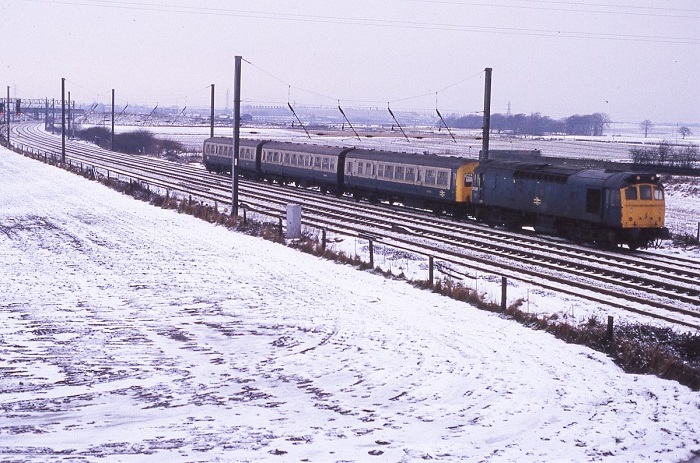
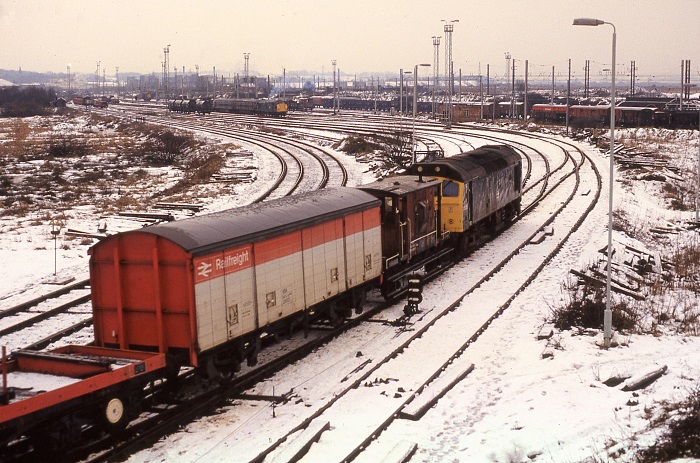
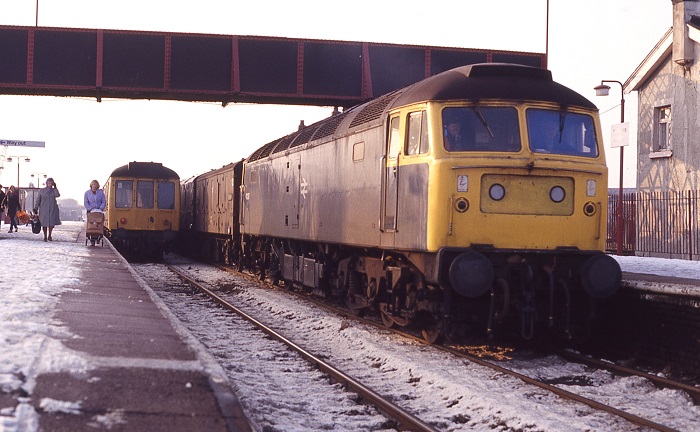
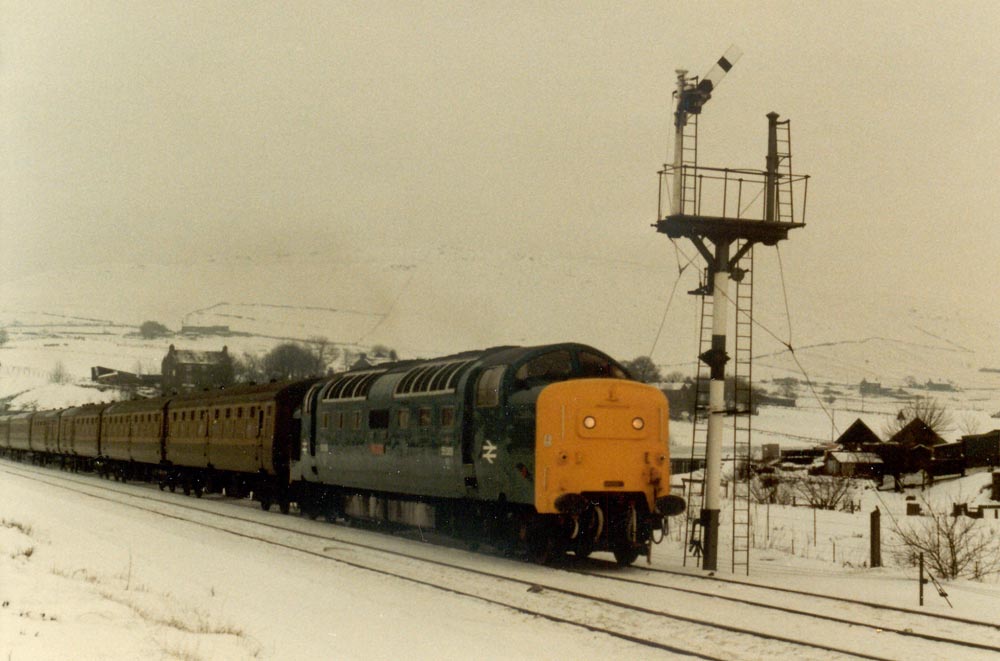
The last week of December was a snowy one, which allowed the Deltic enthusiasts to capture many views of their favourite class in the snow during their last week of regular service. As well as the view shown above, York proved to be an interesting place on the evening of Sunday December 27th with 55007 working a late evening service to London, being noted departing York in quite a blizzard.
On December 28th the 06.00 Glasgow Queen St - Mallaig ran into a major snow drift near Bridge of Orchy, derailing the locomotive (37085) and three coaches. An engineers trolley was used to ferry passengers back to Bridge of Orchy station, going forward from there by bus. The line was not cleared until December 30th.
After a period of three weeks of snow on the ground in many places a thaw set in on December 30th leading to flooding in a number of familiar places including Walsall station. The WR main line north of Exeter being particularly badly hit.
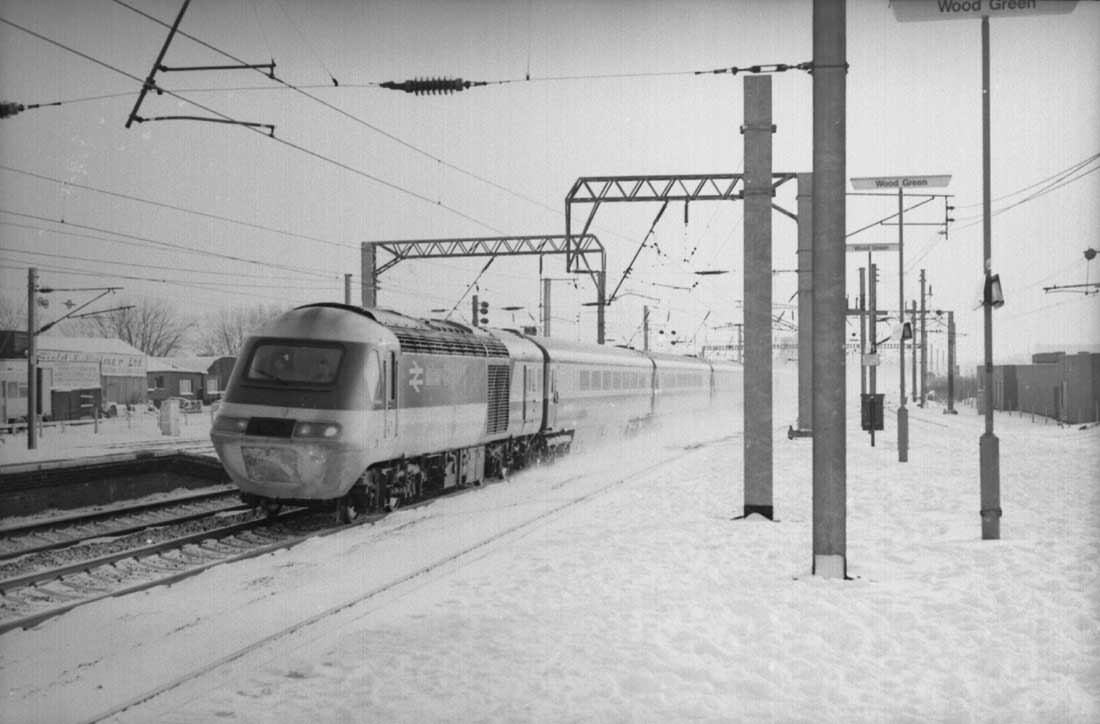
![]()
1982
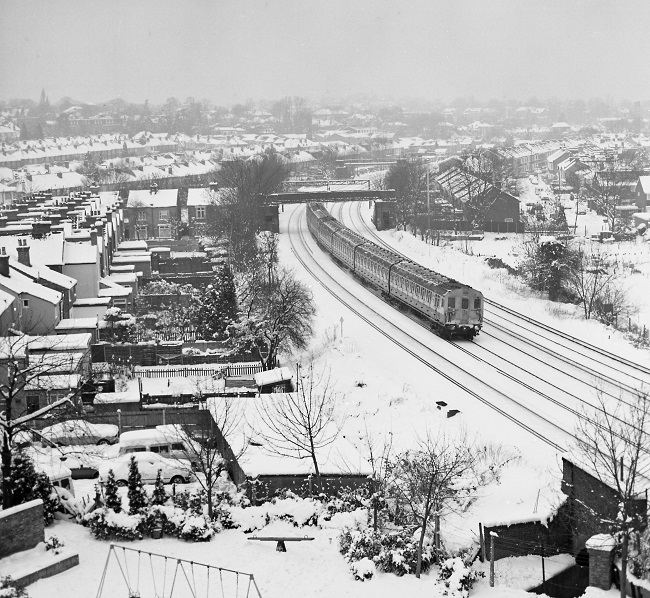
The mild spell over the New Year was short-lived, whilst different troubles for the railways arrived as industrial action by ASLEF commenced, the disruption occurring on two weekdays each week for six weeks. The arctic weather destroyed the BR Euston/Broad Street - Watford Junction services, the Bakerloo service was suspended until the weather improved, the four sets of 1938 Tube stock laying over at Croxley Green depot. However the Class 501 units blocked in the Tube stock from operating on the days of industrial action. Heavy rain swept south on January 3rd, followed by much colder temperatures. Also on this day (3rd) two engineers work trains collided with each other at Roade, blocking all lines for a short period. Regrettably one rail worker was killed. The first industrial action of the year saw strikes on January 4th/5th. Heavy snow fell in the Far North on the 7th spreading south over the next two days. Many of the local Euston services were particularly affected due to a shortage of Class 310 electric multiple units. Typical of many journeys on this day was the 17.15 Birmingham New Street - Leicester, departure was an hour late, with Nuneaton reached after three hours, the Derby suburban unit lacked toilet facilities. 25042 worked a service over the Crewe - Cardiff route on January 5th.
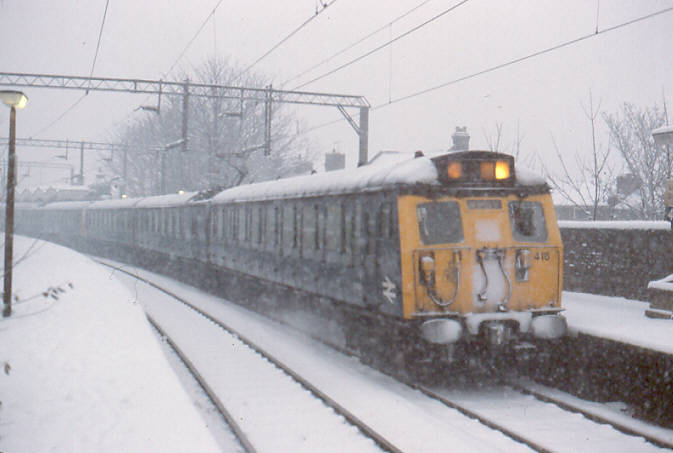
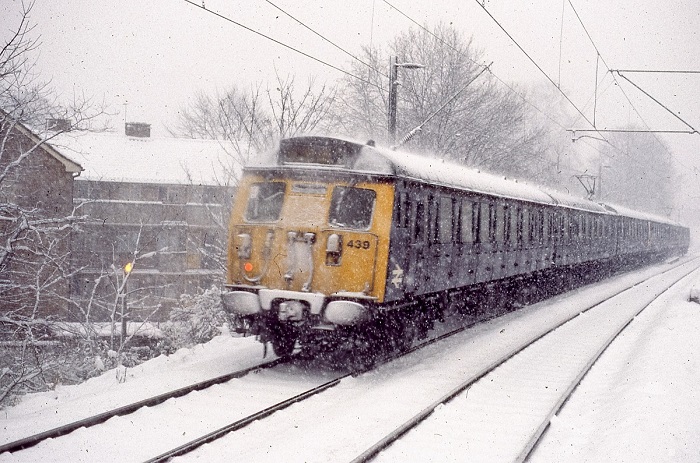
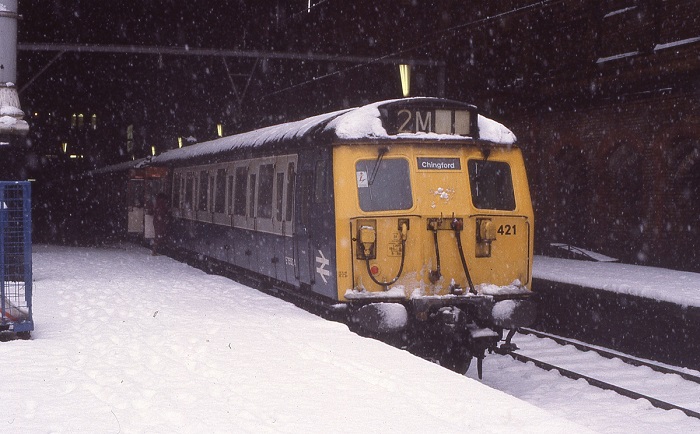
A short spell of living in Bruce Grove required commuting into Liverpool Street using the Enfield line services. In January 1982 a couple of really snowy days are captured at Bruce Grove. Despite the bad weather the local services were running without significant interruption.
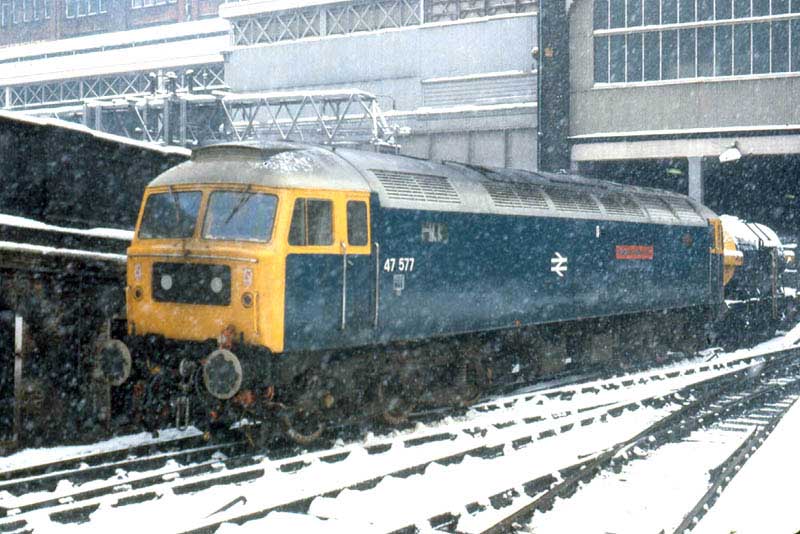
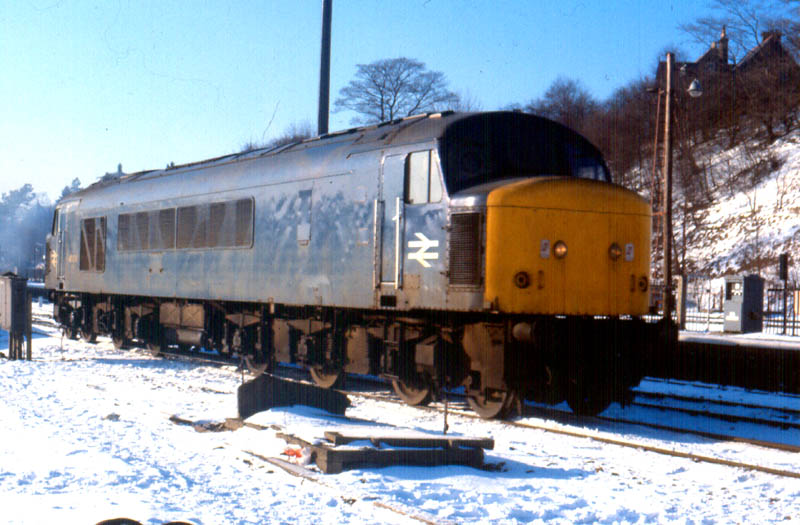
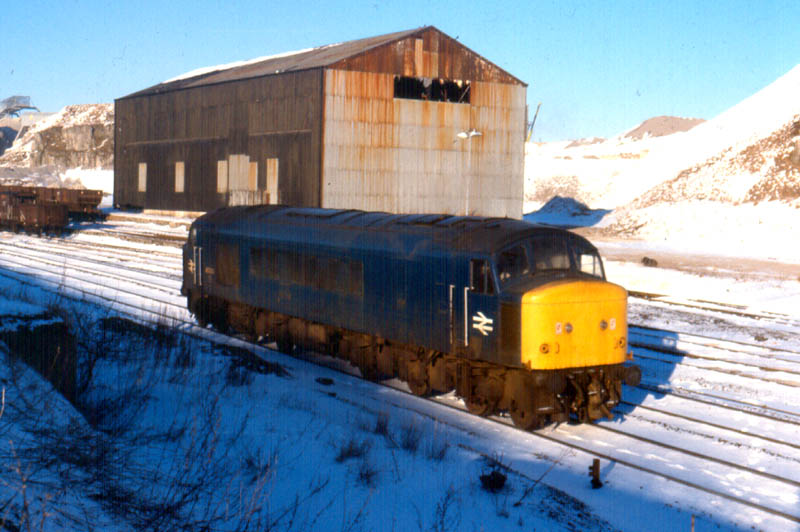
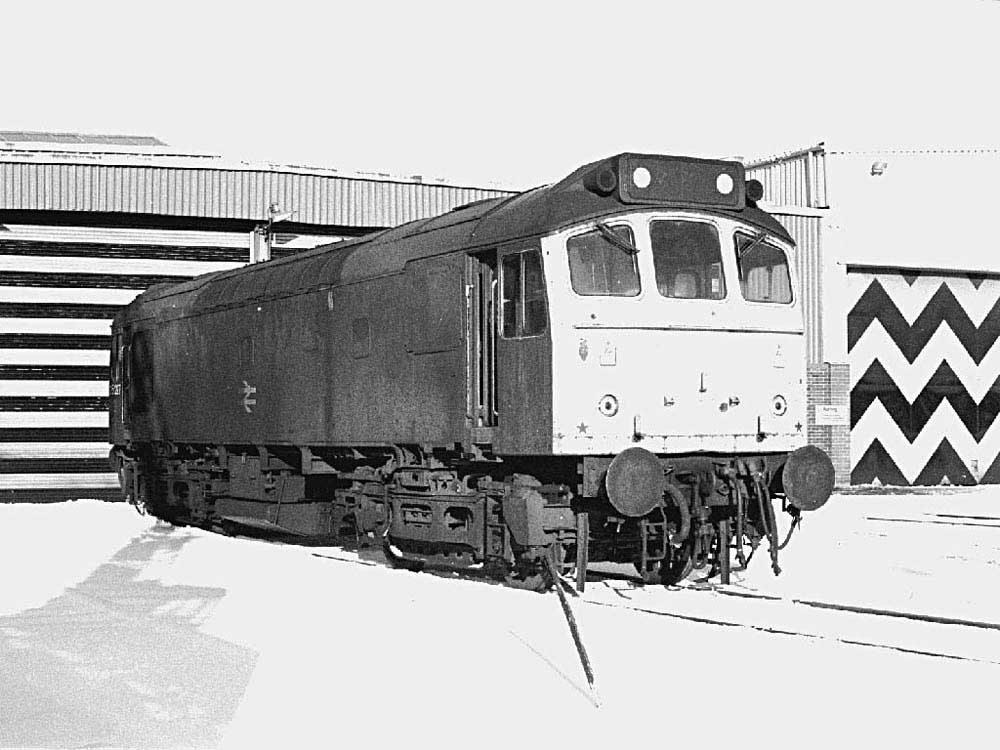
In the midst of all this coldness, on January 5th 27041 set fire to the fuelling point at Eastfield. Apparently none the worse for wear 27041 later set fire to itself at Huntly, this time working January 22nd's 21.04 Aberdeen - Inverness service. The Class 27 was removed from the train and later towed back to Aberdeen. This unlucky machine would reach the end of the year in store at Glasgow Works with collision damage! Also in Scotland, on January 7th, a shortage of locomotives found 20117 diagrammed for the 07.00 Mallaig - Glasgow Queen Street, working the journey throughout, no doubt a chilly ride with no heating available.
The heavy snow storms affected west Wales and the Shrewsbury - Aberystwyth line. High winds in the area caused a lot of drifting along the Dovey Estuary, the snow at Borth Station was above platform height. On the Cambrian Coast Line on January 8th a Barmouth - Aberystwyth diesel multiple unit became trapped in a snowdrift near Tonfanau, the few passengers spending a chilly night with the train until rescued by the RAF the next morning. A rescue train from the south became stuck south of Tywyn, whilst a snowplough sent from Crewe faired little better between Tonfanau & Llwyngwril, all obstructions on this route were cleared by 10th. Further north at Talybont the leading vehicle of a two-car diesel multiple unit derailed, passengers were able to return in the trailing vehicle to Porthmadog, heavy lifting gear being required to re-rail the front car.
A Class 25 equipped with miniature snowploughs, possibly 25260, was sent out on January 8th from Shrewsbury to clear the snow on the line to Aberystwyth. On January 9th 25260 was noted at Aberystwyth with a two-car multiple unit set (56360 & 51176) forming a service back to Shrewsbury. The Class 25's cab front and running gear was caked in snow, suggesting its use to support the diesel multiple unit was a wise move. This operation continued at least until January 11th when 25260 and a three car set were in use. During this period there was only one Shrewsbury - Aberystwyth round trip per day.
Near the Welsh border at Newport (Salop) the nighttime temperature on 10th fell to -26C, an English record, further north at Braemar the thermometer fell to -27.2C, equalling the British record. The Midlands & Wales suffered a further blizzard on 9th.
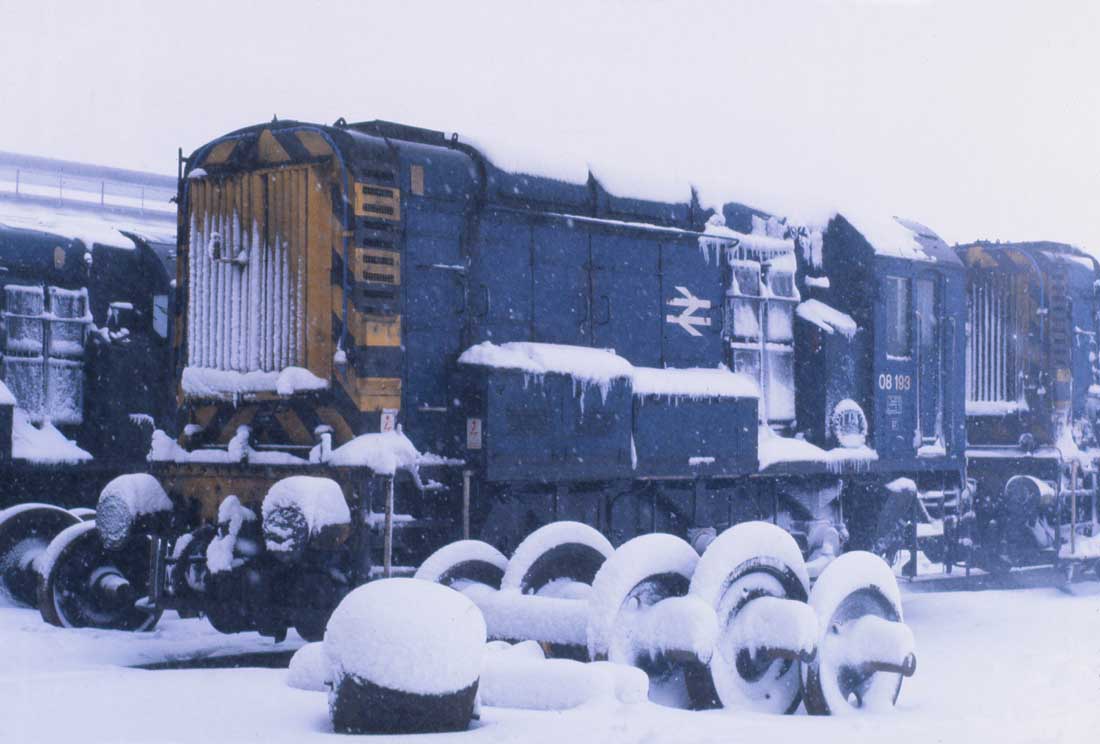
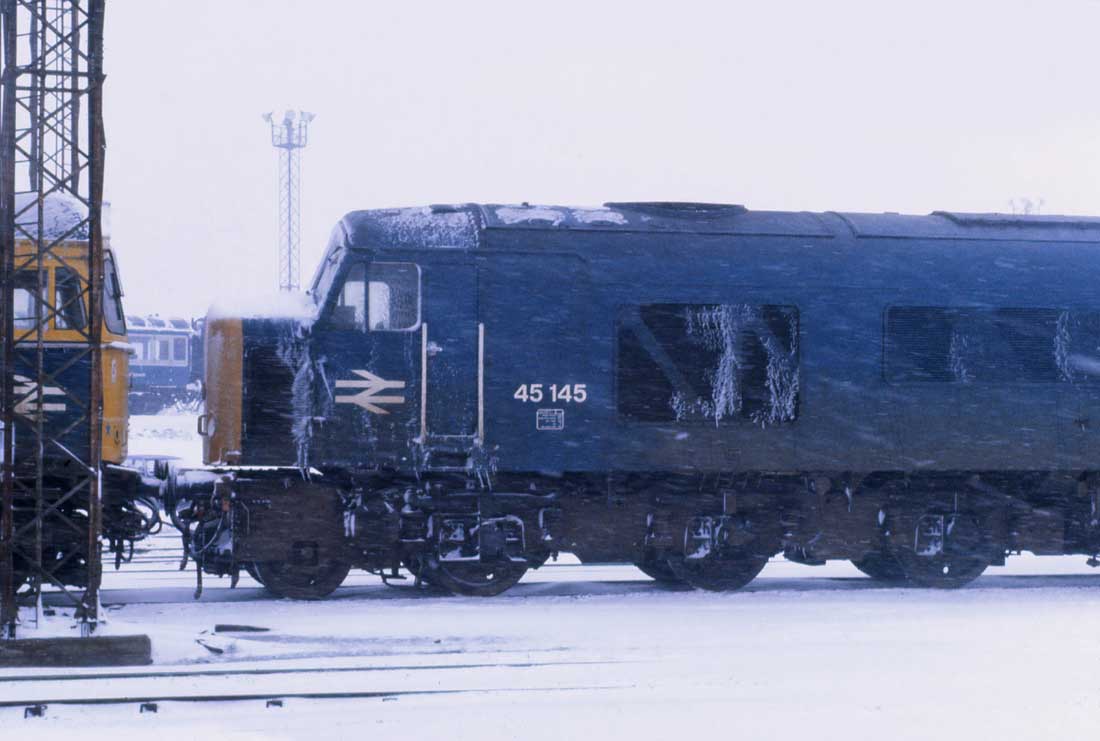
A late afternoon Manchester - Newcastle relief ran behind 25051 & 25152 on January 10th, one hopes the boiler in 25051 was operating. In Scotland an emergency timetable was instituted including the withdrawal of all sleeping cars and a reduction in the number of overnight services. The cold overnight temperatures on 11th crippled the push-pull sets with only two being serviceable, diesel multiple units having to fill in where possible. The emergency timetable halved the Class 26 hauled Edinburgh - Dundee services, whilst the Glasgow - Dundee runs were cancelled except in the rush hours. The shortage of locomotives led to incoming foreign power being borrowed with a number of the named WR Class 47s being particularly well used north of the border. The harsh weather stopped use of the BSC terminal at Hunterston, sufficient to divert the traffic to road hauliers, a matter which was not quickly rectified, causing an outcry from the local authorities between there and Ravenscraig.
In the West Country the long distance services on the 9th were reduced to a shambles. Torquay reported over a foot of snow whilst Weymouth was virtually cut off. At Exeter the 06.35 Bristol - Plymouth behind 45132 was 280 minutes late, the HST powered 07.20 Paddington - Bristol - Paignton service was over 400 minutes late whilst 47535 on the 00.05 Paddington - Penzance was over 700 minutes late. The Carmarthen - Milford Haven line succumbed to drifting snow on 9th, remaining closed for two days. The Central Wales line was hit by blizzards on the 8th, the line remaining closed for ten days. A number of lines in the Welsh valleys suffered similar closures, most freight traffic having been stopped since the 8th, priority being given to the passenger services and just simply keeping the lines open. On 9th the first Paddington - Swansea (diverted via Bristol) took about twelve hours to complete its journey, the 08.42 Swansea - Paddington reached the capital early in the evening! Freezing conditions late on the 10th severely curtailed the few working local services.
On the Southern Region heavy snow crippled services between Eastleigh & Bournemouth, after clearing the casualties it was necessary to institute a diesel hauled service due to the severe icing conditions, these continued until 10th. Inter regional services into this area also suffered badly, not helped by the rolling stock dislocations. The Central Division's woes began on January 4th, with an ASLEF ban on overtime & rest day working, the cold weather took over on 6th, followed by the prolonged blizzard on 8th, with the local services bearing the brunt of the disruptions. The South Eastern division despite the severe weather and isolated equipment failures ran a near normal service until the evening of 11th when a series of failures led to passengers abandoning the trains near Herne Hill. Traction current had to be switched off, with the consequent delays affecting services for the rest of the evening.
With no services running on January 13th/14th, two days of extremely low temperatures assisted in the formation of massive icicles in Kilsby tunnel, causing rerouting of service via Northampton. Further north frozen coal stocks created difficulties at various East Midlands collieries, with many of the wagon doors freezing solid. In the Huddersfield area large icicles and major ice accumulations in local tunnels had to be cleared prior to the re-starting of services on January 15th. From this date the weather eased although the melting snows left flooding in its wake.
The woes of the SR were not helped on January 16th by a violent rear end collision at East Croydon between a Three Bridges - New Cross engineers train and a Brighton - London Bridge parcels service. The driver of 73115 was rescued after some eight hours trapped in the cab, the second man could not be found in the wreckage, not surprisingly because he'd signed on and gone home, a state of affairs quickly picked up by the national newspapers. Further west the blizzards seriously damaged signaling on the Salisbury - Exeter line. A temporary timetable was instituted until the end of January when repairs were completed.
The arrival of March brought gale force winds to the Scottish Region during the night of March 2nd/3rd. Much catenary was brought down south of Carstairs, leading to diesel haulage for several days, strangers filling-in amongst others were 45037 & 46016. Trees down on the East Kilbride branch interrupted services and seas covered the line at Craigendoran Junction.
Snowshowers fell at the beginning of May.
Severe rain storms on June 6th caused heavy flooding in the Kirkham Abbey area, covering the line and trapping the 14.35 Scarborough - Liverpool with 47508. A four car diesel multiple unit covered the roundtrip diagram from York to Liverpool, whilst the local bus company maintained a service between Scarborough & York until the night of June 7th.
On June 25th & 26th operations in South Wales were impacted by severe thunderstorms, with widespread electrical outages affecting the signalling systems on 26th and earth movements at Pontrilas delaying three trains on 25th.
During the evening of October 16th the line at Dawlish was closed for about ten hours due to high seas. Affected trains were terminated at stations either side of Dawlish.
On the late evening of December 9th a brief violent storm in the Fleet area brought down a number of trees, blocking all four lines between Fleet & Winchfield. Three trains struck the fallen debris, two sustained only minor damage, but the 21.46 Waterloo - Bournemouth, led by 4TC No.428, travelling at an estimated 90mph hit a fallen tree, derailing the first three coaches, but the coaches remained upright. No passengers were hurt but the driver sustained minor injuries. Full availability of the lines was not achieved until December 12th.
The middle of December (14th) saw heavy snow fall in Cheshire.
There was light snow noted on the southern Pennines on December 22nd.
![]()
1983
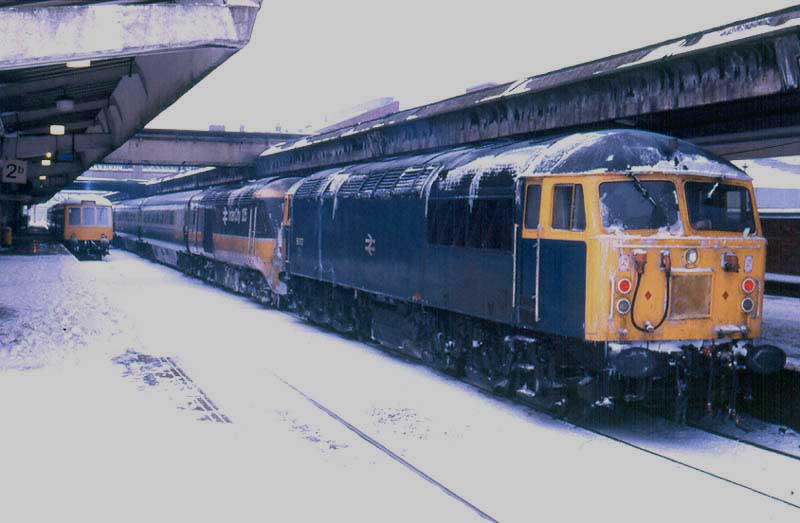
Snow fell in the middle of February, particularly in the south & east (Virginia Water - Ascot, Woking - Basingstoke, Camberley & Alton areas). During February 33207 was noted in the Dover area on snowplough duty with a plough at each end of the locomotive.
During the afternoon of July 6th south west London was hit by severe thunderstorms, a signal relay room at Twickenham was hit by lightning causing localised signal failures. Flooding halted all services at Richmond station for four hours. District Line services were also impacted. A Class 33/1 & 4-TC were borrowed from the Kensington Olympia - Clapham shuttle to provide limited service betweem Barnes & Twickenham. The evening peak services from Waterloo were disrupted by displaced train crews. Five days later during the afternoon of July 11th hot weather caused a rail on the down line to buckle at Eltham Well Hall, causing disruption for the remainder of the day.
A brief period of high winds and heavy rain on the afternoon of October 15th caused delays between Redhill & Guildford due to fallen trees.
On December 9th high winds brought down trees causing disruption to services around Guildford, Romsey & Weybridge.
![]()
1984 Although cold & snowy weather predominated in January the New Year began with a major fire at Ayr depot, destroyed/damaged in the conflagration were seven railcars and considerable parts of the structure. Apart from this hot-spot much of January was plagued by storms causing dislocation of services, especially on the WCML where the overhead line equipment was particularly vulnerable.
Gales in the north on 2nd affected services south of Carstairs. More gales accompanied by heavy snow returned on 13th/14th damaging the overhead equipment near Thankerton and further south at Preston, causing disruption and cancellation of many WCML services. 25048 made a round trip between Wigan & Preston assisting two WCML electrically hauled services through the damaged area. To ease congestion some WCML services worked out of St Pancras on 14th, the 17.40 to Liverpool Lime Street featured 25207 all the way to Nuneaton! A chilly trip was handled by 25284 working the 13th's 08.40 Carlisle - Glasgow Central, it did not return on the balancing working! It is uncertain whether the snow storms contributed to a Glasgow - Largs service colliding forcefully with the buffers at Largs, five passengers requiring hospital attention. In the south heavy rain fell, making it the wettest January since 1948, extremely high winds were reported with tornadoes seen in Doncaster (14th) and Teignmouth (26th).
Heavy snows on January 22nd in places to a depth of two feet blocked both the GSW & CR routes into Scotland, with drifts of fifteen feet being reported. Engineering work on the ECML was quickly postponed, although too late to prevent one ECML passenger train being diverted towards Carlisle, then having to retrace its steps after word of the snow blockages spread. The failure of the 23.40 Edinburgh/Glasgow - Bristol near Crawford was not helped by the rescuing locomotive becoming stuck in a sizeable snowdrift. The gale force winds did nothing to help matters, quickly undoing the arduous work of the snowploughs. The down 'Clansman' became stuck at Dalwhinnie, somehow an ex-Glasgow service forced its way alongside taking all the passengers to Inverness. It was several days before the stock of the 'Clansman' was freed from the snow. In later snow clearing operations here 26044 suffered serious fire damage, leading to withdrawal. The most affected train was an overnight Inverness - Euston service that was initially diverted via Aberdeen, suffered a partial locomotive failure, reached Motherwell only to find the way south blocked. A circumnavigation of the Hamilton circle found the train headed for Kilmarnock and the GSW route to Carlisle, having taken fifteen hours to cross the border. The 23rd's 10.15 Euston - Glasgow used 25185 & 25212 between Carlisle & Newcastle, as nothing was available at Newcastle to replace the Type 2s the train was terminated here, with the empty coaching stock returning to Carlisle. Many services were cancelled, others running many hours late, to ease the problems all freights north of Carlisle were cancelled.
Further north the 21st's 14.15 Fort William - Glasgow Queen Street ran into a snowdrift near Bridge of Orchy, services not resuming until 27th. Passengers from this train spent several days in local hotels. The lines north of Inverness were closed by snowdrifts, with the 17.55 Inverness - Kyle stuck west of Achnasheen and the 18.00 Wick - Inverness trapped at Scotscalder. RAF helicopters quickly located the ex-Wick train rescuing all the passengers despite appalling weather conditions. For the Kyle passengers helicopter rescue took place the next morning. Although the storms had predominantly affected Scotland snow fell as far south as the north Midlands.
The bad weather continued into the first week of February with heavy snow and storms accompanied by high winds. Possibly these conditions led to an afternoon Inverness - Aberdeen service being double headed by 25175 & 47157 on February 1st. Three days later Perth turned out 25236 for the 17.10 to Arbroath, continuing with the 18.35 Arbroath - Dundee.
The beginning of March found snow across much of the Pennines.
On June 17th severe storms impacted lines north of London. The line between Great Missenden & Aylesbury suffered several landslips, which impacted signalling into the next day. In the aftermath of the storms buses substitued for many services. Also on June 17th heavy rain and storms found electric multiple unit 310054 hit by lightning near Bletchley, damaging the pantograph. A following service pushed the unit into Bletchley, however this coupled with the heavy rain and numerous track circuit failures disrupted the WCML timetable for the rest of the day.
A lengthy and severe storm in the South East, including London on October 5th resulted in localised flooding and interuption to communications equipment affecting a variety of services.
![]()
1985
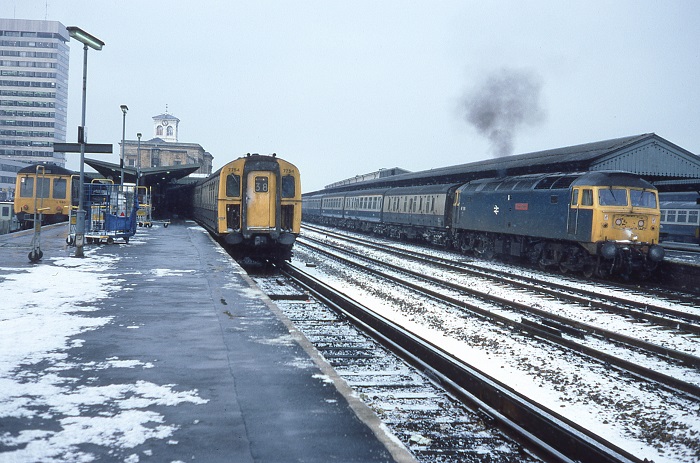
Heavy snowstorms and flooding created many difficulties during January, Kent was particularly badly hit on January 5th with Ramsgate & Margate receiving eleven inches. Heavy snow had fallen in the south and west earlier in the month, after a brief warm spell the bad weather returned with a vengeance, the 16th being one of the coldest days this century, especially in the south & accompanied by more snow. In the Highland a blizzard struck on 19th. After the snows came flooding, on January 22nd the Lowestoft line was closed following flood damage to a bridge near Ufford.

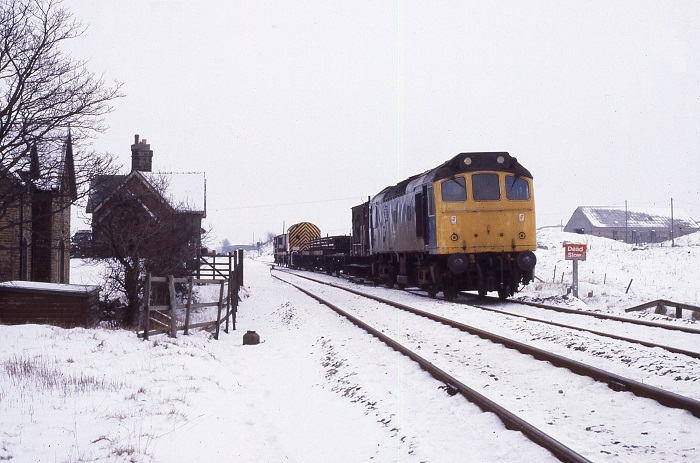
Heavy snowfalls on February 8th & 9th caused many problems on the southern end of the WCML. Freezing temperatures and the heavy snowfall also brought serious delays to the South Wales area. In the south the morning rain soon turned to snow, falling for most of the day leading to a variety of stock disruptions and service cancellations. Shortages of equipment were exacerbated by the backlog of overdue maintenance and by the end of the miners strike at the beginning of March with the consequent return of 'borrowed' locomotives for the resumption of coal movements.
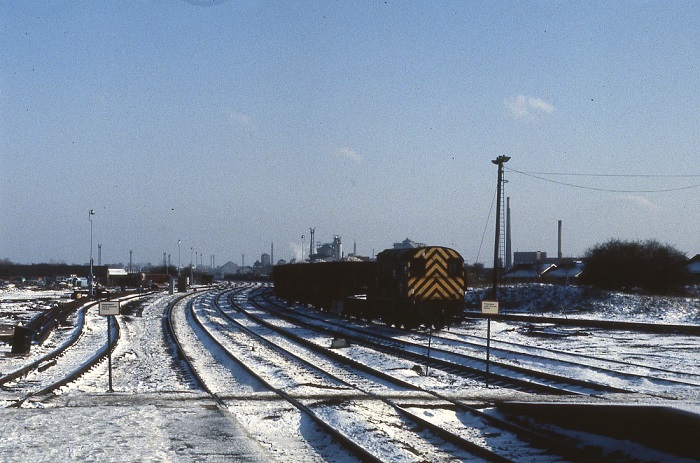
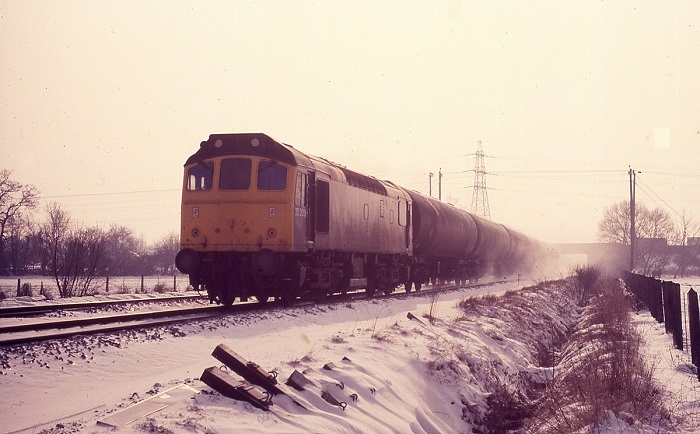
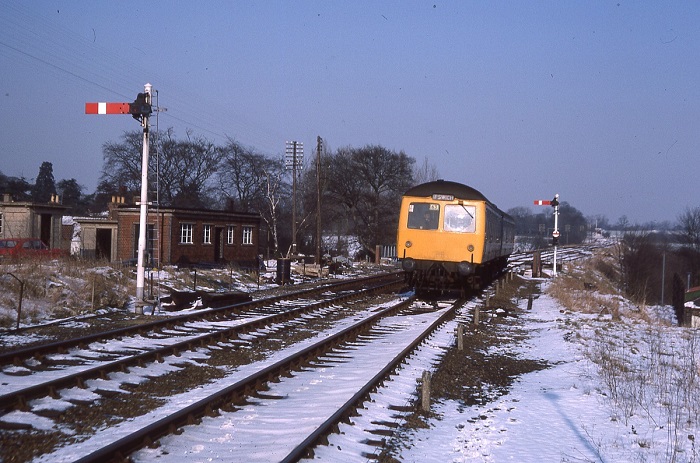
Bedford - St Pancras commuters on February 15th endured -15C temperatures, which proved too much for the Class 317 electric multiple units leading to scratch sets of four Mk1 corridor seconds and non-boilered Class 25s filling in. By the time of the evening rush hour the ice on the overhead equipment had gone and problems with the electric multiple units frozen brakes had been cured, releasing the Class 25s from their temporary passenger duties.
The freezing weather returned on the 18th again causing considerable problems on the Southern. Most notable were the icicles in Balcombe tunnel which broke windows in 4-CIG 7437, a few days later falling ice in Haywards Heath tunnel displaced the conductor rail. At Selling tunnel icicles caused considerable damage to new cars being brought up from Dover. Snow was upto the railhead in the Southampton area (18th).
On March 21st more snowfalls in the south caused problems for the first electric trains of the day.
Heavy rain over Scotland on September 23rd/24th caused multiple problems. Six inches of rain locally flooded Winchburgh tunnel, the push-pull services provided extra stops whilst the local multiple unit services were cancelled. A landslip occurred between Hamilton Central & Hamilton West, blocking both lines and keeping the lines closed for at least a month. A landslip also occurred near Greenhill Lower leading to single line working and a diversion of some services. Elsewhere a bus service was required between Carnoustie & Arbroath after the trackbed was washed away at Easthaven.
During November there was snow in the south on 18th whilst in Scotland the month ended on a wintry note.
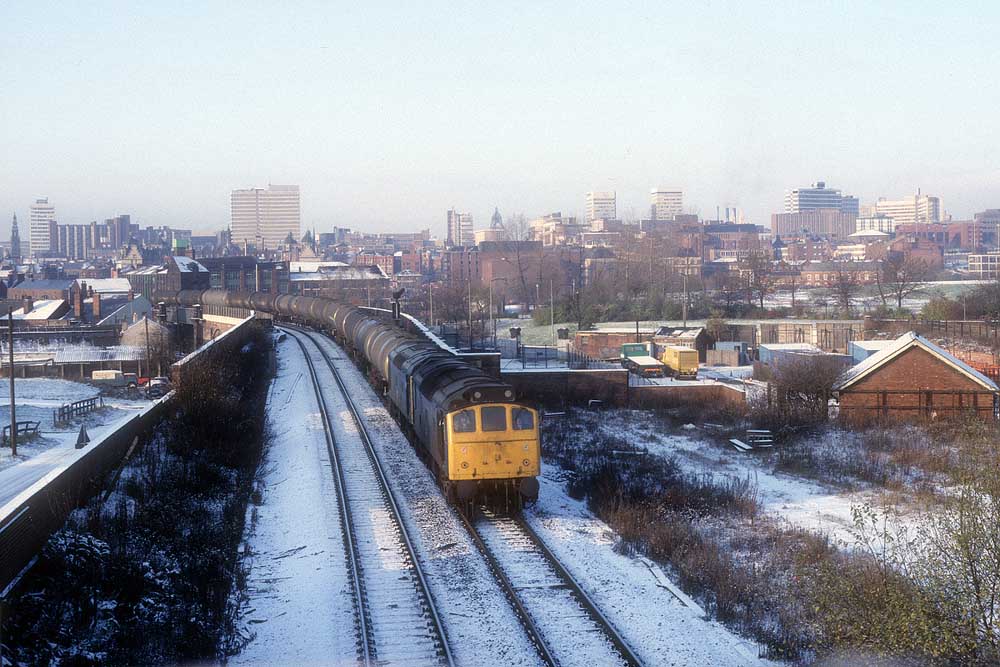
In late December there was a spell of snow and cold temperatures, particularly in the east.
![]()
1986 Snow fell over parts of the Southern Region on January 2nd/3rd.
Easterly winds brought heavy snow on February 5th causing numerous problems, the cold weather, especially in the east, highlighting the ailing heating systems in many of the aging diesel multiple units. With the snow came heavy icing in all the regular places on the WCML, particularly at Kilsby tunnel.
Freezing conditions at this time brought more ice related problems to the WCML, so severe was the freeze that certain bridges in the Harrow area had to be cleared before traffic could move, again Kilsby & Linslade tunnels were particularly affected. Snowfalls on 5th & 6th were heavy, again the eastern half of the country receiving the most. On 5th a number of services were diverted into Paddington. The extremely cold weather caused major problems for the sand trains operating at Caldon & Oakmoor, with the loads being frozen into the wagons!
Heavy snow in the Brighton area on February 7th caused serious delays, particularly to the London services.
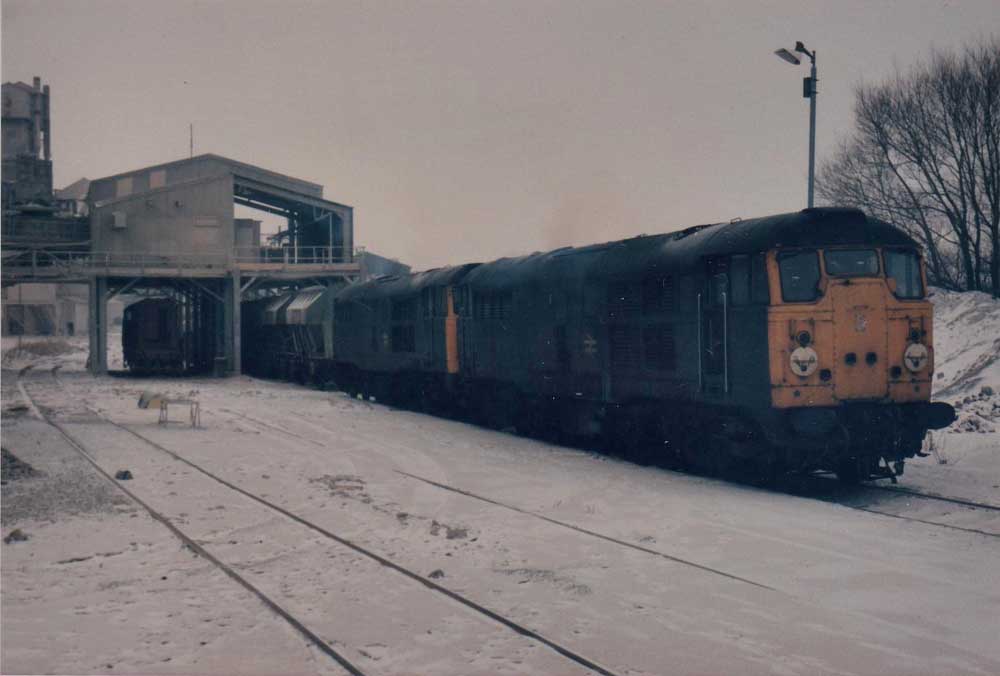
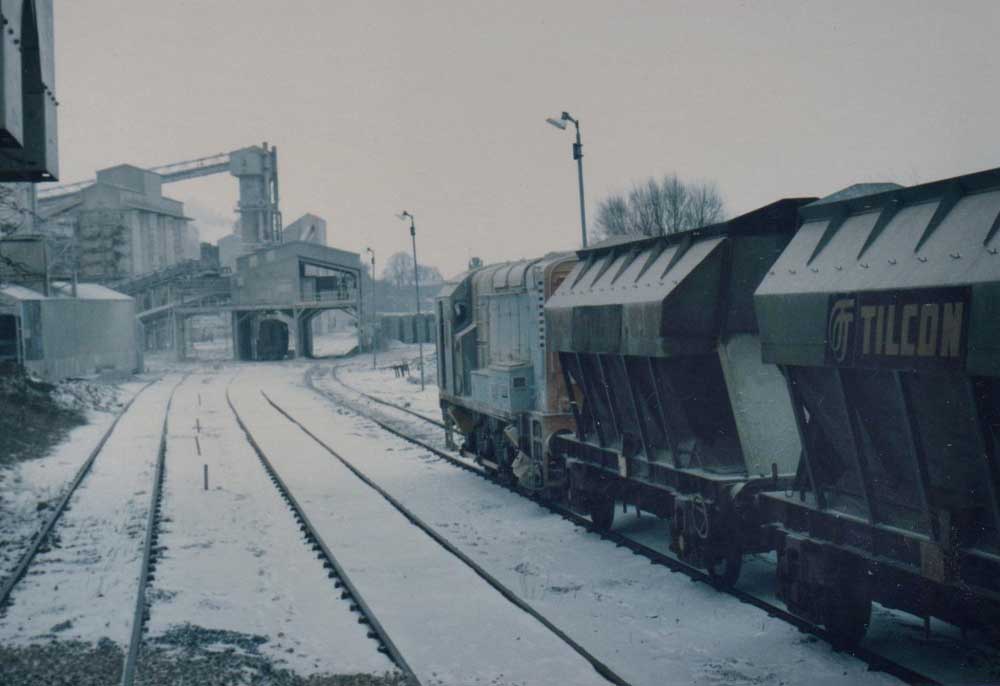
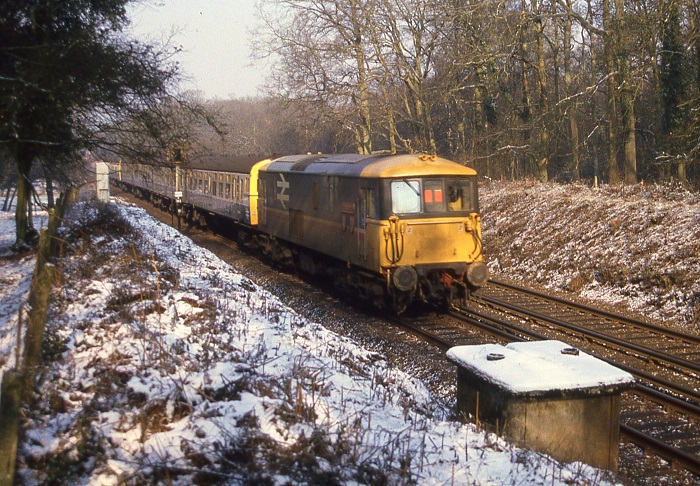
There was about two inches of snow on the ground in the Penzance area on an overcast February 23rd.

On March 24th high winds brought the overhead wires down in several places between Rugby & Tring. Diversions took place to St Pancras and Paddington whilst bus services bridged the gap on the WCML. It took several days to fully restore services with speed restrictions in place due to the continuing windy weather. High winds on March 26th affected some Southern Region services due to trees and other debris blocking lines.
On May 26th strong winds brought the overhead wires down on the WCML (north of the border?). This resulted in the 09.50 Paignton - Glasgow Central being diverted via Hexham with 25249.
Heavy snow fell over the Cairngorms on June 10th.
![]()
1987 Much of eastern England, the Midlands & Scotland succumbed to heavy snowfalls beginning the night of Sunday 11th and on into January 12th - 14th. Although the West Highland line was not affected by the weather the 13th's 05.50 to Fort William was delayed 450 minutes awaiting the through coaches from Euston. In the Glasgow area services were suspended on the Hamilton Circle, Cathcart Circle & their branches, and to East Kilbride & Springburn. The Glasgow Central - Edinburgh via Shotts service was still not operational by the 14th whereas most other Glasgow area services were running by this point. The Edinburgh - Glasgow via Falkirk services battled snowfall of a foot on the first day and were additionally delayed by a points failure at Polmont. By the evening of 12th services generally were heavily delayed or not running. More snow fell on the 13th causing delays over the Falkirk route, particularly with the longer distance services. Snow continued to fall on the 14th, an HST was noted arriving at Edinburgh from the north behind a Class 37. Temperatures eased on the 15th allowing for a more normal timetable to operate. The Inverness area escaped much of the severe weather, though trains from the south were as much as five hours late.
In the north-east heavy winds produced severe drifts which completely disrupted the local diesel multiple unit services on Tyneside & Teeside, the freezing conditions affecting the availability of the diesel multiple units and track problems associated with frozen points. Few trains ran until an emergency service was instituted on January 15th. On 16th the 09.45 Newcastle - Edinburgh parcels used snow plough equipped 47644, this machine had in fact been restricted to the Newcastle area for snow clearance, it was replaced at Berwick by 37238, the Class 47 returning south.
In the Leeds area a similar toll was taken on the local Class 141 diesel multiple units, with only one - 141005 - noted in service on 13th, the older diesel multiple units filling in as best they could. A drastic reduction occurred in the merry-go-round workings out of Knottingley due to the bad weather, leading to higher than normal freight workings over the following weekend.
However it was in the south-east that conditions were most seriously felt for the railways. On 12th no trains ran to or from Southend Victoria, it was not until towards the end of the week that any semblance of a service was instituted out of Liverpool Street to Shenfield & Ipswich. Elsewhere out of Liverpool Street stock formations became very jumbled with a multitude of combinations operating. On the non-electrified lines things were equally as interesting, a Cambridge service on 14th was formed of a parcels diesel multiple unit attached to a mail working whilst the 16th's 16.05 to Cambridge was a Class 31 and three coaches. On 16th a Reading based Class 117 worked turns on the Sudbury branch, until it failed on 21st! The relaying of information was not helped by the train indicator boards being out of service at Liverpool Street on 12th & 13th due to their relocation. The sidings on the former site of Ipswich MPD soon became a resting place for many failed, frozen up diesels.
Out of Kings Cross the snow of the 12th quickly reduced the long distance HST workings to chaos. A heavily overcrowded 17.03 Kings Cross - Peterborough took over two hours to complete its journey, whilst the 12th's 14.00 Aberdeen - Kings Cross reached the capital at 4.00am on 13th, the following 16.00 ex-Aberdeen was cancelled at Newcastle. No Peterborough - Kings Cross commuter HST services ran on 13th. An hourly Kings Cross - Edinburgh & a two hourly Kings Cross - Leeds timetable was established for 13th & 14th, but as more HSTs became available the frequencies were increased from 15th. On 14th Leeds borrowed a NE/SW HST set (253044, power cars 43035 & 43142) for a morning service to Kings Cross, who then used it for an afternoon turn to Edinburgh!
The snow in the Peterborough area saw most services operating about two hours late. By the 14th the large snowploughs were called out to deal with drifts on the line between Peterborough & Grantham. On the cross-country route a number of Tyseley diesel multiple units covered for unavailable locomotive hauled stock formations, the Peterborough - Hitchin locals were cancelled for several days to allow use of the diesel multiple units on Cambridge area services.
In the West Midlands the heavy snowfalls caused major disruptions on 13/14th, with long periods without any services. It was early on the 14th that heavy snow with driving winds caused further major problems on the southern end of the WCML. Icicles on the tunnels through the Chilterns required special possession for their clearance. Frozen pipes on the rolling stock affected passenger facilities on the trains with reduced toilet & catering facilities. By 15th an hourly service was operating to Euston, by 16th things were much improved but most services were running slightly late. On 16th 45136 was in charge of a rake of Mk1s, some labelled Network SouthEast, on the 11.19 Newcastle - Cardiff, normally a HST turn. Elsewhere on the WR a number of services were seriously disrupted, the 14th's 09.43 Newcastle - Penzance was noted at Newton Abott some eighteen hours late, the 19.00 Paddington - Plymouth HST (43186 & 43126) required assistance from 33034 west of Exeter.
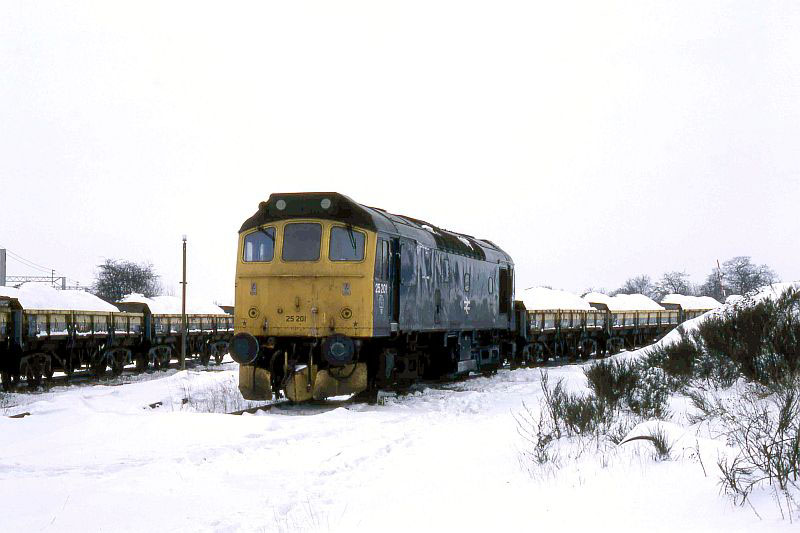
25201 had earlier worked the Guide Bridge - Hartshill working on January 13th. The TOPS report showed it as out of service at Nuneaton on January 17th with loss of power, could its entrapment at Hartshill have something to do with this? It would be withdrawn at Crewe in the early hours of January 29th 1987.
On the Southern Region the heavy snow caused havoc with the third rail electrified system, whilst snow ingested by the electric multiple units caused many failures to traction motors and other electronic components. Again the snow starting falling on Sunday 11th with more heavy snow during 13/14th. The South Western division probably came off with the least disruptions, but they were still considerable. By 14th little was moving between Waterloo & Woking with many of the outer surburban routes completely blocked by snow or ice covered conductor rails. Included in this category were the lines between Guildford - Portsmouth, Brookwood - Ash Vale, Farnham - Alton, Surbiton - Cobham - Guildford, Guildford - Redhill & Raynes Park - Epsom. 3H diesel electric multiple units covered the Waterloo - Exeter service as far as Salisbury on a number of occasions, 205030 so noted on 16th. By the weekend of 17th things were returning to normal despite a number of cancellations due to stock awaiting attention.
The Central Division was hit hard as heavy snow, icing and equipment failures slowly destroyed the timetable on 13th. By the afternoon of 13th East Croydon was pretty much isolated from all directions with northbound services terminating at Gatwick. Early points failures at Selhurst, stock failures at Purley and high winds causing severe drifting did not help as the authorities fought a losing battle with the weather. The 14th's 06.25 Newhaven Marine - Manchester Piccadilly hauled by a Class 33 terminated at Gatwick at 11.00am, it was left in the station as all the sidings were full of frozen up units. Central Division lines closed included the Tattenham Corner branch, Redhill - Guildford, East Grinstead, Hurst Green - Uckfield, Sutton - Epsom & Epsom Downs, Three Bridges - Horsham, Horsham - Dorking, Lewes - Keymer Jct and Hastings - Ashford. On the Brighton line an hourly service was running on 15th as were many others services starting to re-appear on previously closed lines, most saw some sort of service by the 16th. As expected the stock used was not always that normally diagrammed for the routes. The Uckfield line saw services taking five hours to reach Uckfield on 13th, services were suspended from 14th. Snowdrifts of over ten feet required the use of a Class 33 and snowplough on 15th, one such drift had trapped Class 207 No.207018 near Hever Road Bridge, Edenbridge, a rescue attempt with another diesel electric multiple unit failed, a second attempt with 205002 only resulted in its derailment. A Class 33 and the Stewarts Lane breakdown crane rerailed the unit on 16th, but it was not until the next day that 33033 arrived to tow the two units back to Norwood Junction. Continued drifting snow required the ploughs on 17th/18th prior to services restarting on 19th. No inter-regional services ran until 18th.
On the South Eastern Division a similar picture of heavy snow and icing from the 11th onwards quickly led to a meltdown of the services operating, with a request on the evening of 11th to avoid travelling where possible. During 11th big gaps started to appear in the schedules, not helped by the complete failure of 4-CAPs 3205/06 near Sittingbourne. The 22.30 Charing Cross - Dover Priory diverted via Maidstone East is reported passing Ashford at noon on 12th! The 13th's 06.00 Charing Cross - Margate is reported by the BBC as arriving 6.5 hours late at Ramsgate. By 15th services were operating though the Petts Wood - Bickley, Maidstone East - Ashford, Rainham - Sittingbourne, Sittingbourne - Sheerness & Faversham - Dover still remained blocked. Those trains that were operating were usually of two 4-car electric multiple units hauled by a Class 33, 47, 56 or 73. London bound trains reversed between Cannon Street and Charing Cross to keep the locomotive on the front for the trip back out to the country. Combinations so noted at Dartford included two 4 CEPs with 56001 and corridor stock attached to 56062. A two 4 VEP and two car de-icer combo had 33027 at one end with 73142 at the other. From 12th onwards diesels with eight-car electric multiple unit combinations provided service out of Charing Cross. Diesels so noted included 33008/13/16/44/48, 33207, 47131/144/235/330/372, 56056, 73002/106/116/140/142. The use of 56056 was later switched to working a shuttle between Tonbridge & Tunbridge Wells. Diesel electric multiple units returned to the Hastings line, including 1011 and a WR unit No.L588. The Paddock Wood - Strood branch reopened on 16th with the assistance of 47450 and a 4CEP. By lunchtime on 18th instructions had been recieved to remove the locomotives from assisting the electric multiple units. To help with snow clearance the Aberdeen based Beilhack snow blower and support vehicles were noted on the worst affected lines on 17/18th.
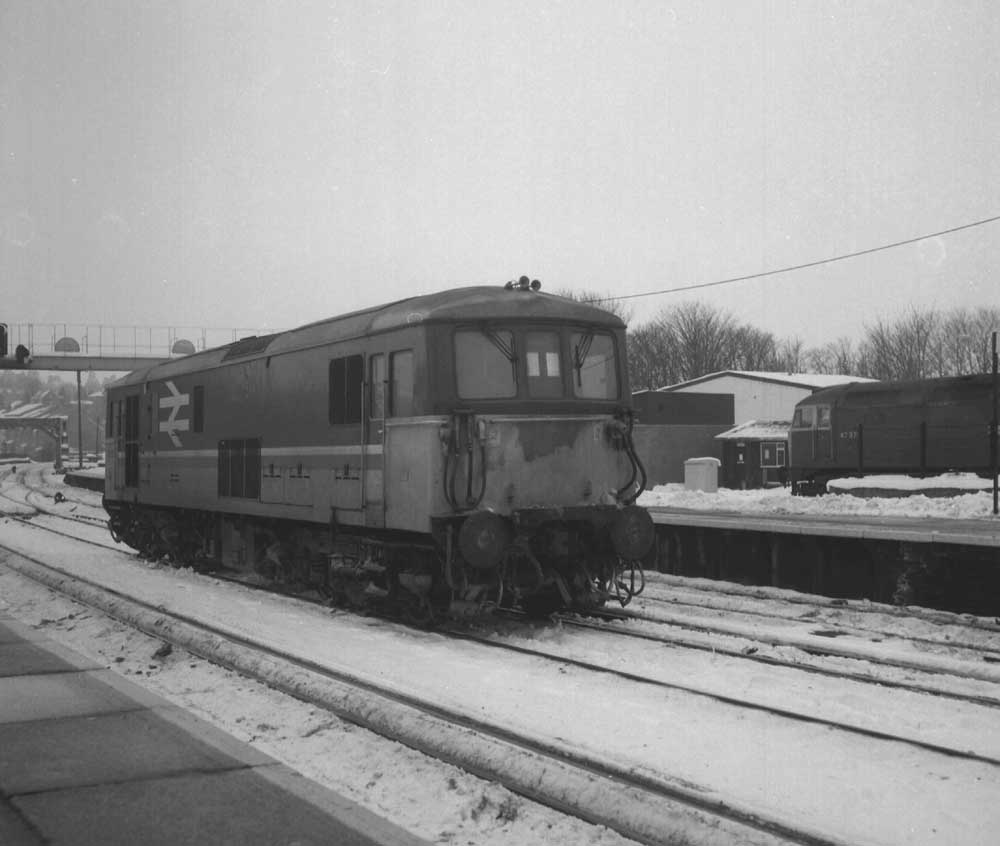
During the early hours of March 19th heavy, wet snow fell over much of Hampshire & Wiltshire. The type of snow caused tree branches to droop which fouled the railway lines. This delayed services between Salisbury & Romsey, and the West of England mainline as well as the Southampton - Bournemouth line.
In the early hours of Friday October 16th the southern & eastern parts of the United Kingdom were overtaken by a weather event which caused widespread chaos and in particular much devastation to the railways. During the early hours of Friday winds in excess of 100mph tore through the region, bringing down thousands of trees, many of which blocked a multitude of lines and rail facilities.
Southern Region For the Southern Region the crisis became front & center when the power tripped out at 04.25am. As dawn brought light to the south and east a myriad of railway workers from all departments joined by contractors & Army personnel set about tackling multiple challenges, from clearing fallen trees to putting to rights damage caused to stations and other structures. In some areas the general public volunteered to help. The physical damage and its related costs were phenomenal.
Sole Street Bank had one quarter mile of track completely covered with trees. Between Tonbridge & Hastings at least 300 trees were toppled. Over 2,500 trees had fallen south of East Croydon whilst north and south of Haywards Heath tree falls were very significant. The Mitcham Junction, Carshalton and Sutton areas also suffered significant tree falls as did the line between Upper Warlingham & Oxted and between Oxted & East Grinstead. The Portsmouth - Guildford line suffered from multiple tree falls.
Dover Western Docks station (used by Sealink & Hovercraft passengers) sustained considerable damage, losing 300 panes of glass which landed on the platforms and caused damage to stabled stock. The storm undid much recent construction work at the nearby Admiralty Pier, removing at least 240 tons of ballast which deformed the rails. The carriage sheds at Gillingham and Chart Leacon sustained damage. Glass canopies at Waterloo, Bournemouth, Victoria, Brighton, Hove and Worthing were damaged, temporarily closing some platforms whilst the station canopy at Dartford was damaged and a canopy collapsed at Angmering. Many roof tiles at Otford station were blown away and a sub-station at Lenham (Ashford) was damaged.
Other related damage included chalk falls between Dover & Deal and the collapse of a retaining walls in the Woolwich area. A low hanging live high voltage CEGB cable disrupted services in the Bognor Regis area. A fallen tree derailed a train near Bagshot early on Friday morning.
London Midland Region On the London Midland Region within an hour of the rain and winds arriving electrical power was lost as the National Grid sustained considerable damage, power to major areas in the south and east was cut due to damage and to protect the rest of the electrical grid. Prior to this event debris blown about by the high winds damaged the overhead electrical equipment in many places, including Kentish Town. These caused the local circuit breakers to trip out, then as mentioned previously the complete loss of power occurred as the National Grid failed, leaving such major terminii as Euston & St Pancras in the dark. It also blacked out all signals and other equipment as far north as St Albans. At about 7am the Bedford - St Pancras commuter service was suspended as damage mounted and as overhead line crews worked to replace damaged infrastructure, generally working southwards to St Pancras as the winds abated. Glass sheets were torn from the roof of St Pancras, landing on the concourse without causing any injuries. By 8am the route south of Bedford was sufficiently clear to allow the passage of HST services.
The conditions on the WCML were similar to those out of St Pancras. Movement was not possible south of Watford, with overnight expresses held at Rugby, Coventry & Nuneaton and many Inter-City services cancelled. By 9am electric services could reach as far as Harrow & Wealdstone. At Nuneaton the southbound Motorail service was unloaded of its cars at a disused good dock.
Eastern Region On the Eastern Region high winds, flying debris & 2,000 fallen trees damaged over 960 miles of overhead line equipment. The forecasted high winds led to the imposition of a 60mph speed restriction on all GE services. But within five hours over 400 incidents had been reported to Liverpool Street Control, initially of a routine nature, but then transitioning to the sublime. This led to the decision at 04.17am to suspend all GE traffic movements. Apart from the multitude of trees blown down, Limehouse station lost its roof, Benfleet station canopy was blown off, at Leigh on Sea beach huts and boats were blown onto the tracks, whilst at Stamford garage roofs littered the tracks. At Barking part of the signalbox roof was blown off, a level crossing gate at East Tilbury was blown off its hinges.
Aftermath & Clean-Up (by Region)
As the morning wore on and the full light of a gloomy day spread across London, the railways in the south & east were a hive of activity. But not the normal one of running a train service, this morning thousands of railway workers and many others were engaged in putting to rights the havoc brought about by hurricane force winds and heavy rain. The winds were still gusting strongly and heavy rain was present. Many of the rail workers had been called to duty shortly after the storm erupted in the wee hours of Friday morning, others had been on duty at the time and ended up working far beyond their normal shift length. Others in trying to report for duty couldn't reach their regular work location and ended up signing on at the nearest railway location.
In many locations material trains were run to assist in the removal of debris. Civil engineering works scheduled for Sunday were cancelled.
Debris from the fallen trees and leaves stripped from the trees frequently left a mess on the railhead, causing wheelslip on many vehicles, leading to flat-spots and the need then to reprofile the wheels. Sandite trains were brought in to improve adhesion at the railhead.
Compounding the difficulties was the loss of direct BR and British Telecom telephone services, those that remained in operation were heavily overloaded.
Southern Region For the Southern Region the massive clean-up operation was controlled from Woking signalbox by General Manager Gordon Pettitt. Additionally for three days a helicopter was chartered for use by the Permanent Way maintenance assistance (general) to RCE to assist the General Manager with conditions on the ground and to establish priorities. Particular importance was given to the Woking - Waterloo, Havant - Haslemere, Brighton - Three Bridges, Sevenoaks - Ashford, Ashford - Swanley and the Swanley - Faversham lines. From the air it became apparent that as the storm had moved eastward so the damage and number of fallen trees intensified.
A priority for the Central Division was to re-open the London - Brighton line, being hardest hit in the South Croydon & Haywards Heath areas. Army troops from Maidstone Barracks were called into assist.
When the power was lost at 04.25am a number of electric services became stranded, whilst the fallen trees literally trapped some trains. These included the 03.10 London Bridge - Sittingbourne newspaper train which became trapped beyond Dartford and a coal train at Albany Park.
On the South Eastern Division 24 hours after the storm the lines between Tonbridge - Hastings, Tonbridge - Ashford - Dover, Ashford - Hastings, Canterbury East - Dover, Ramsgate - Dover, Strood - Maidstone West, Swanley - Maidstone East & Swanley - Medway towns remained closed.
By Saturday the South Western Division were running a near normal service on the Portsmouth and Bournemouth/Weymouth lines. However the lines through Liphook/Liss remained blocked.
Regrettably early on Sunday afternoon a member of the Gravesend Track Maintenance gang was killed whilst involved in tree clearance activity near Greenhithe Tunnel.
London Midland Region The Bedford based overhead line crews had been called out at 3am on Friday morning, they would work continuously until midday Saturday to repair the damage. By midday Friday electric services were operating between Bedford & St Albans, from here a diesel multiple unit shuttle was established to St Pancras. Later on Friday afternoon service was available to Moorgate and by early evening the timetable for HST operation from St Pancras was back in almost full operation.
On the WCML by 9am electric services were available to Harrow & Wealdstone, by 11am services could now reach Euston. For the longer distance services stopped at Rugby, Coventry & Nuneaton the devastation in the London area was relayed to the detrained southbound passengers, who realising the hopelessness of further travel mostly returned northwards on improvised services. Those wishing to proceed south urgently were found taxis. Gradually shuttle services were able to reach Bletchley & Watford and just before noon passengers were able to head south on a Coventry - Paddington special.
Eastern Region Since the London - Southend Victoria line had sustained the least amount of damage it was given first priority for getting back into service. Then followed the routes to Cambridge & Norwich.
Wiring crews from Cheshunt, Colchester, Pitsea & Romford were joined by Balfour Beatty construction staff engaged on the ECML electrification project were spread across the region to restore the overhead wires.
By Friday afternoon diesel powered services radiating from Norwich were in operation, as were services on the Cambridge - Kings Lynn route and the branch to Peterborough.
Saturday afternoon saw the restoration of the London - Southend Victoria services, as were the electric services between Colchester & Clacton. By Sunday afternoon electric services had been established to Cambridge as had the London - Norwich services, whilst by Sunday evening trains were reaching Tilbury & Shoeburyness from London.
By the end of Monday only the Upminister - Romford line remained blocked.
Postscript British Rail estimated the storm cost GBP9 million, which included lost revenue, manpower costs and damage costs. Network SouthEast estimated lost revenues at GBP3 million, whilst repair costs were GBP 4 million for the Southern Region and GBP 2 million for the Eastern Region. To some extent the timing of the storm helped the railways recovery efforts, with 94% of its scheduled trains running during the Monday morning peak, albeit with some routes entertaining considerable delays.
On Monday November 19th tragedy struck the 05.28 Swansea - Shrewsbury two-car diesel multiple whilst attempting to cross the River Towy near Glanryhd (four miles north of Llandeilo station). A weekend of torrential rain had blanketed the area, thus the driver was accompanied by a Swansea customer services manager and a permanent way inspector, all located in the cab to monitor the trackwork. As the multiple unit slowly crossed the five span bridge several of the piers collapsed. The leading coach settled at an angle into the water, with the three crew in the front cab and the guard escorting passengers to safety. Unfortunately before everyone had been evacuated the leading car then slipped below the waters, trapping the driver and three passengers underwater, regrettably all four perished. It is presumed that debris carried down by the river, including such items as large trees and telephone poles had weakened the stone piers to the extent that collapse was imminent. The rainfall in the area had been reported as six inches in a 24 hour period, with many local roads and rail lines flooded, at Carmarthen station floodwaters had reached platform level.
Heavy rains on the night of November 20th washed away much of the leaf debris on the railhead, but also brought problems to the Portsmouth - Havant line due to an earth slippage and flooding in other areas causing line closures.
Heavy rains on the morning of November 21st flooded the line near Sway, causing some cancellations and buses operating between Brockenhurst & Bournemouth until the late morning. Also affected earlier the same morning was the line at Botley, but the flooding here caused far less disruption.
![]()
This page got a bit long so more additions will happen sometime.
The tale below appeared on the 'World Diesel Loco' yahoo group a while back, I think it refers back to Christmas 2002 and brings back similar memories of the antics on BR during my commuting days in London during the late 1970's.
I hope nobody minds it being posted here, just nostalgia....
Quote:
Now then, to stop repetition, I've written this out and am sending it in one go......apologies for being a bit "railwayish" in places to those of you not in the know !
As you may be aware (I've moaned about it enough), I was working the last (23.20) train from Manchester Victoria to Rochdale last Friday 19th December. Now, I was dreading this, as it would be amateurs night, with the office workers overdoing it before finishing over the Christmas hols. However, not even in my worst nightmares did I figure on a Blue (Cheesy pop pap!) concert taking place as well at the MEN Arena (which is right above Victoria station for those of you in the sticks).
Anyway, I arrive at Victoria from Wigan at 22.40, and decide to get a brew from the mess room before venturing any further. I ambled onto the platforms at about 23.00, and hundreds of people were out there, looking for their trains home. With all the mither from the drunks, it took me about 10 minutes to walk to the train on platform 4. Normally a single 142 will take them all home, but FNW had laid on a 156 and a 142 on the back. At least I'd have a bit of luxury !
Anyway, I squeezed past the passengers, and got in the cab, put the key in and started the engines up. I was just getting comfy in the chair when I noticed a bloke, mid 50's, looking decidedly poorly on the platforms. He was "sat" in a rack where they put the free "Metro" newspapers. I had my head out of the window, just watching what was going on, when a bloke asked me if this was the train for Rochdale. "Yes Sir" I reply, and he turns to Mr Poorly and shouts to him that it's his train. Oh dear. Mr Poorly gets up and staggers to the train.
Now in a 156, the doors are right behind the cab, so he was right behind me, swaying beside the train. I was praying for him not to get on, because he was green. I've never seen anyone that colour before, and knew he was going to be trouble. Nevermind, departure time loomed and a couple of minutes late, the guard closed the doors and the station staff gave me the RA - Go ! Well, the brake came off, and I applied power. The engines revved - but the train wouldn't move. Eh ? Brakes off, engines revving and taking load - what's going on?
I decided to get out, and opened the cab door. Again - for those who don't know - you enter and leave the cab through the passenger gangway (where the doors are).The carriage was full, with about 15 people in the gangway behind the cab alone. I squeezed past them, and went to the back of the train. Hmm. The 142 was sitting there, coupled up to the 156, but with engines off and lights out. Funny I thought. There weren't any engine stop lights on in the 156. Then it struck me. The units had been coupled up in the platform by another driver, who had thoughtfully only done half a job. To couple two units, you drive one on to the other and do a "pull away" test. This means putting the train in reverse and applying full power - just to see it the coupling has locked the two together. If okay, you then press the "couple" button, which opens the electric circuits between the two trains. To test this is okay, you do a brake test in both trains.
Well, it was obvious that the happy fellow who'd coupled them hadn't pressed the couple button, so the 142 was acting like a ball and chain to the 156. Hmm. A quick word with station staff and the signaller, and permission was given to uncouple and recouple. As both trains were packed, I did this very gently, and the job was done ! Only 10 minutes late now, I went back to the front of the train to get in and move off.
But, as soon as I opened the door, a mad woman passenger started howling "how dare you lock me in a train with you not on it. How dare you, you *#~%ing idiot....". Whoa, I'm not standing for this, so I shouted to her "OUT". She started again, poking a finger in my chest. So I said "Right, Out now,. I'm not moving until you leave the train".
At this point, husband pipes up "oh sorry driver. She's claustrophobic. I'll keep her quiet". Seeing as it was Christmas (nearly) and having further assurances from him that order would be kept, I got in the train, entered the cab, and tried to move the train. Oh dear. The brakes won't come off now. Hmm. I look out of the cab window. There is an orange hazard light lit on the carriage that I'm in, which means several things, such as there is a door open, or the passenger alarm (passcom) has been pulled. So, I open the door into the gangway, and notice both passcom handles have been pulled. But the crowd are now getting shirty. Why aren't we moving, what's up now they ask. I point out that someone has pulled the passcoms, putting the brakes on.
I also asked who did it - and fifteen hands point to the claustrophobic lady ! I tell them that they can thank her for the delay, reset the alarms, and get in the cab. Brakes off, power on - WE'RE OFF ! Only 20 minutes late. When you're in the cab, you can hear everything said/done behind you, so was alarmed when I heard a big bleugh and a lot of screaming, Oh dear. Mr Poorly has been sick. Violently so........ I get out at the first stop - Dean Lane. Mr Poorly is slumped by the door, sitting in a pool of his own creation. It's all down his black coat as well, and looks like red cabbage. I get back in the cab sharpish. But, when the guard closes the doors, the one behind me that Mr Poorly is leaning on won't close. I go out, and pull it shut, standing in his "night out". At every stop, I have to do this until we get to Oldham, where Mr Poorly gets off, and the door starts behaving ! The Claustrophobic lady gets off at Shaw, shouting and bawling at me as she does so, and I breathe a sigh of relief as most people have got off the train.
When we get to Milnrow, someone knocks on the door. It's a youngish lad, asking when the train will get to Glossop. GLOSSOP!!!!! Wrong train, wrong station mate. Manchester PICCADILLY for Glossop !! He takes this quite well, explaining to his "hidden" mates that "we're staying in Rochdale tonight lads". Oh dear. We arrive at Rochdale only 35 minutes late, get the stragglers off, and the fly down to Rochdale (no Black box on 156461 yet !). Arrive on the shed and compare notes with the guard. He's looking a bit worried - he's only been on the job for three weeks......unlike a seasoned old lag like me (passed out 19 months!) Merry Christmas !
Snowy days in the 1960s
Snowy days in the 1970s
Page added April 15th 2004.
Last updated November 23rd 2024.